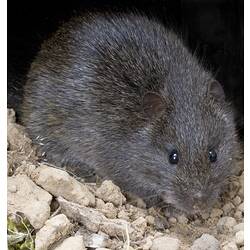General Description
Body fur dark brown, usually lighter underneath. Feet, ears, and tail dark brown. The ears are short and do not reach the eyes when folded forward. Tail shorter than head and body. Body up to 20 cm, tail up to 14 cm. They can be distinguished from the non-native Black Rat by their relatively short ears and tail. The tail is about equal to the head and body length whereas the tail of black rat is much longer than the head and body. They have dark brown feet which distinguish them from native Bush Rats.
Biology
Swamp Rats make tunnels through the vegetation. They eat mostly stems of grasses and sedges. They are restricted to native vegetation and avoid areas of human habitation. Frequent fires will prevent them from recolonising an area. Swamp rats are close relatives of the Bush Rat. Both are native to Australia where they have been present for about 1 million years. They are both in the same genus, Rattus, as are the invasive rats, the Black Rat, Rattus rattus.
Distribution
Eastern mainland Australia and Tasmania.
Habitat
Coastal heath, sedgelands, dune scrub and grassland areas.
More Information
-
Animal Type
-
Animal SubType
-
Brief Id
Dark brown rat with short ears, brown feet and a dark tail that is shorter than the body.
-
Colours
Brown
-
Habitats
-
Where To Look
-
When Active
Nocturnal, Diurnal
-
Diet
Herbivore
-
Diet Categories
Grasses
-
Endemicity
-
Commercial
No
-
Conservation Statuses
CITES: Not listed, FFG Threatened List: Not listed, EPBC Act 1999: Not listed, IUCN Red List: Least Concern
-
Taxon Name
-
Scientific Author
(Gray, 1841)
-
Common Name
Australian Swamp Rat
-
Kingdom
-
Phylum
-
Subphylum
-
Class
-
Order
-
Suborder
-
Superfamily
-
Family
-
Subfamily
-
Genus
-
Species Name
lutreolus





